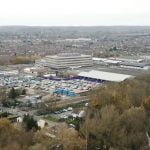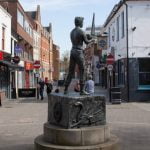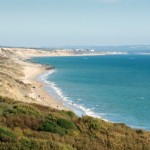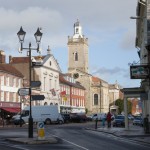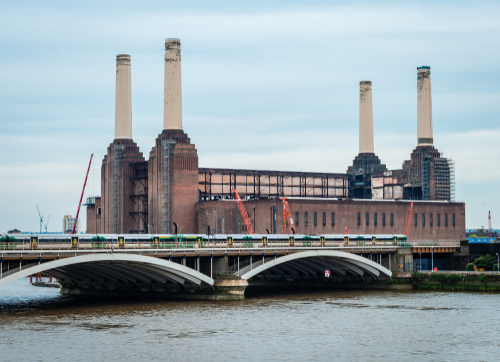
A quick guide to the London Borough of Wandsworth!
Overview
The Borough of Wandsworth is located in southwest inner London, along the south bank of the River Thames. In 1965, the London Borough of Wandsworth was formed from the former Metropolitan Borough of Battersea and about two-thirds of what was the Metropolitan Borough of Wandsworth. Wandsworth borders the boroughs of Lambeth to the east, Merton and Kingston Upon Thames to the south, Richmond upon Thames to the west and the River Thames to the north. The borough’s main districts include Roehampton, Putney, Wandsworth, Earlsfield, Battersea, Tooting, and parts of Clapham and Balham. Public open spaces are extensive throughout the Borough, covering approximately one-seventh of the total land area. Famous green spaces include Battersea Park, Wandsworth Common, Tooting Common, Putney Heath, and parts of Clapham and Wimbledon commons. The annual University Boat Race between eight-man rowing crews of Oxford and Cambridge starts near Putney Bridge. The Borough of Wandsworth has an area of approximately 34 km2 and, as recorded at the 2011 UK Census, a population of 306,995.
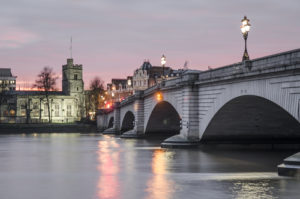
Putney Bridge – close to start-point of annual Oxford Cambridge Boat Race
A Very Brief History
There is evidence of both Iron Age and Roman settlement along the Thames at Putney. The Roman road Stane Street ran through the southeast part of the borough. It’s also thought that there was a crossing point across the River Thames for ferries at Putney during the Middle Ages. Wandsworth takes its name in part from the local River Wandle, and from the Saxon word ‘worth’ which signifies either a village or a shoreline. In Doomsday-book of 1086, the Wandsworth place name is spelt as ‘Wandesorde’ and ‘Wendlesorde’; in other ancient records as ‘Wandlesworth’ or ‘Wendlesworth’. The Wandsworth parishes of Battersea, Putney, Tooting Graveney, and Balham were also all recorded in the Domesday Book.
The River Wandle, which bisects the borough, has strong historical associations with the growth of industry in London. From the 13th century onwards the river began to be used by industry, initially by fullers, who were employed to clean cloth (particularly wool). In 1685, a great number of French Huguenot refugees fleeing religious persecution after the revocation of the Edict of Nantes came to settle in the Wandsworth area. They brought with them a great number of abilities, including weaving, felt making, hat making, joinery, smith and merchant skills. In the 17th and 18th centuries, the suburbs of Putney and Roehampton became popular with the well-to-do, who were looking to escape overcrowded Central London. Up to the middle of the 19th century, Wandsworth still consisted mainly of farmland, market gardens, the parkland of the grand estates, and the open heathland of Wimbledon and Wandsworth Commons. However, after the arrival of the railway in 1884, urbanisation of the borough and the subsequent growth of industry took place on an ever-increasing scale. Great numbers of terraced houses were built to accommodate the working classes who arrived in the area to work in the locally based manufacturing industries. In 1851, the population of the borough was around 30,000 but by 1901 it had risen to more than 300,0000.
Between June and November 1895, Wandsworth Prison, which was built in 1851, famously held controversial Irish author and playwright, Oscar Wilde, as a prisoner before he was transferred to Reading to complete his 2 years sentence. In 1965, notorious great train robber Ronnie Biggs made his escape from the Wandsworth Prison to Brazil, via Australia. He did not return to the UK to face the rest of his jail term for another 46 years. Notable authors who have resided in Wandsworth for some period during their lives include William Makepeace Thackeray, Mary Wollstonecraft Shelley, Voltaire, Daniel Defoe, George Elliot and Thomas Hardy.
London’s first electric cinema house, The Premier Electric Theatre, on Garratt Lane, which connects Wandsworth with Tooting opened on Saturday 18 June 1910. It had an auditorium with 800 seats. The cinema was renamed after the 2nd World War as “The Rex”. The last film was shown in April 1960, whereby it then became The Rex Bingo Club. The building was demolished around 1987.
Today, there are many new or refurbished buildings along the borough’s prosperous riverside including the large Chelsea Bridge Wharf. Important buildings in the borough include; The Peace Pagoda, in Battersea Park, The London Heliport, London’s main and busiest heliport is just beyond Battersea Park, and south of the heliport is New Covent Garden Market. South Thames College, Southside Shopping Centre (Wandsworth) and The Exchange Shopping Centre (Putney) are among the largest secular structures. Notable listed buildings include Battersea Power Station, Battersea Arts Centre, The Royal Hospital for Neuro-disability and Wandsworth Town Hall. In Old Battersea, two fine masonry mansions that survived ‘The Blitz’ are Old Battersea House and Downshire House, both which hold Grade II listed status.
Did you know?
- At 1665, Wandsworth has the highest capacity of any prison in the UK
- The UK’s (and possibly the world’s) oldest public railway, The Surrey Iron Railway, opened in 1803. It was horse-drawn and ran for 9 miles from Wandsworth to Merstham.
- In 1926, Southfields in Wandsworth became home to London’s first purpose-built mosque
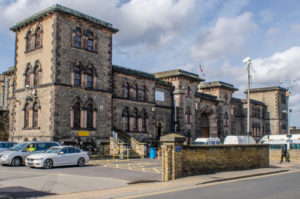
Wandsworth Prison – built in 1851
Getting Around!
It’s generally recommended not to drive in Central London as it’s far easier and more convenient to get around on the train or tube. You find the following railway and tube stations situated with the Borough of Wandsworth:
Railway Stations
- Balham
- Battersea Park
- Clapham Junction
- Earlsfield
- Putney
- Queenstown Road
- Tooting
- Wandsworth Common
- Wandsworth Town
Underground (Tube) Stations
- Balham
- Clapham South
- East Putney
- Tooting Bec
- Tooting Broadway
- Southfields
Things to see and do!
Wandsworth is particularly noted for its parks and open spaces which cover around 15% of the total area of the Borough, and are listed below. The other main tourist attractions in Wandsworth, including museums, are also listed below.
Tourist attractions
- Battersea Beer Festival
- Fazl Mosque
- Northcote Road Antiques Market
- Putney Sculpture Trail
- Southside Wandsworth
- Three Standing Figures 1947
- Tooting Bec Lido
- Wandsworth Common Windmill
Museums
- Couper Collection
- De Morgan Centre
- Wandsworth Museum
Parks and open spaces
- Battersea Park
- Clapham Common
- King George’s Park
- Lambeth Cemetery
- Putney Lower Common
- Putney Old Burial Ground
- Putney Vale Cemetery
- Mary’s Cemetery, Wandsworth
- Tooting Common
- Wandsworth Common
- Wandsworth Park
- Wimbledon Common
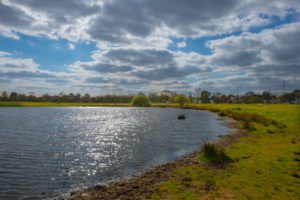
Rushmore Pond – Wimbledon Common
Where to stay?
If you’re on a budget there are some offerings of hostel-style accommodation in or close to Wandsworth. There’s plenty of B & B/Guesthouse/Basic Hotel accommodation. If you’re looking for a bit more luxury then there’s also plenty 3, 4 and 5-star hotels in the area. An alternative would be to rent an apartment – most have no minimum let period. While the majority of apartments cater to couples, some can accommodate up to 6 people. Indicative prices for the most readily available types of accommodation/per night, based on 2 adults sharing are as follows:
Hostel: £20 – 40
B & B/Guesthouse/Basic Hotel: £60 – £125
3/4/5 Star Hotel: £125 – £350
Apartments vary greatly based on no. of available berths, location and standard
If you enjoyed this guide, be sure to check out our other London guides by clicking the link below.
